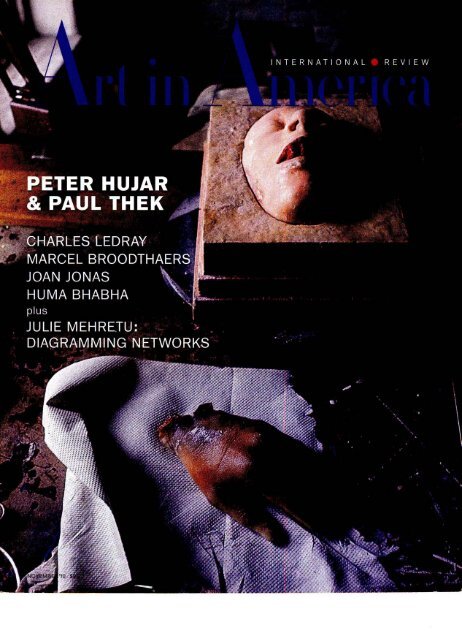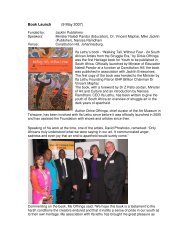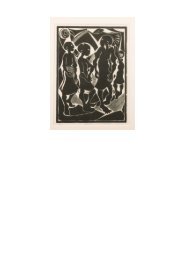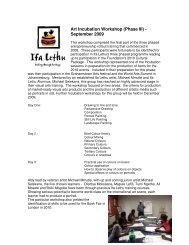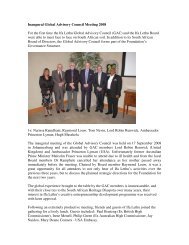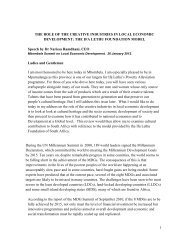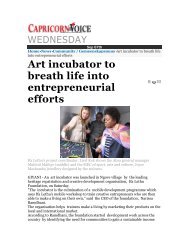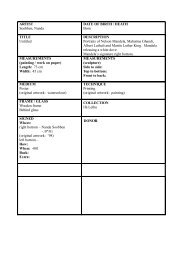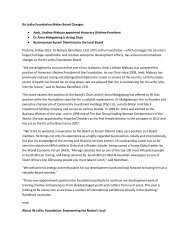Exiles' Return - Ifa Lethu
Exiles' Return - Ifa Lethu
Exiles' Return - Ifa Lethu
You also want an ePaper? Increase the reach of your titles
YUMPU automatically turns print PDFs into web optimized ePapers that Google loves.
SCUTH AFRICA RXP&KY<br />
EXILES' RETURN<br />
Spurred by a donation fronn a fcrrner Australian diplornat and ccllectcr,<br />
the lfa tethu Foundation today strives to repatrrate<br />
"struggle-era"<br />
works<br />
by Scuth Africa's largely self-taught black artists<br />
EY STEVEN O DUEIN<br />
SOUTH AFRICA UNDER aoartheid was<br />
a place of secrets, lies, disinformation,<br />
cover-ups and censorship-along with<br />
pervasive physical and psychological<br />
trauma. But the establishment of democracy<br />
in 1994 has spawned the desire for<br />
healing, as well as attempts to recover<br />
whatever has been lost, be it tangible<br />
or intangible. On the artistic front, this<br />
means recuperating the visual landscape<br />
of that period-most notably, the work of<br />
black artists who by and large were<br />
shunned by local white audiences and<br />
institutions. The recovery initiative aims<br />
to enlarge our understanding of contemporaneous<br />
creative expressions, credit<br />
people whose accomplishments have<br />
been overlooked and establish a legacy<br />
for future generations (the so-called<br />
"born-frees").<br />
lt is a daunting task. But<br />
history is being rewritten in part through<br />
efforts by the lfa <strong>Lethu</strong> ("Our Heritage")<br />
Foundation. which reoatriates art taken<br />
out of the country by diplomats, journalists<br />
and other foreigners during the<br />
1970s and '80s. Behind this undertaking<br />
lies a tale of past intrigue and<br />
present-day generosity.<br />
The story goes back to a cheeky<br />
23-year-old Australian on her first diplomatic<br />
posting, to Pretoria, in 1974.<br />
Diane Johnstone, while still a student,<br />
had demonstrated against a tour of<br />
the all-white South African Springboks<br />
rugby team to her country in 1971. To<br />
her horror, she arrived in South Africa<br />
at a time when it was not unusual to<br />
see police beat black people mercilessly<br />
in the streets. One of Johnstone's<br />
primary duties as Third Secretary was<br />
to supply political reportage, which<br />
could directly impact her government's<br />
policy-making. But the black townships<br />
were essentially off-limits to whites.<br />
The arts became her point of entry.<br />
Johnstone was befriended by two<br />
American diplomats, Jock Covey and<br />
Frank Strovas, who had established their<br />
bona fides among local black activists<br />
by organizing multiracial jazz sessions.<br />
Many of the musicians were visual artists<br />
as well-musical themes are commonplace<br />
in the works produced then-and<br />
only six months into her assignment<br />
Johnstone organized an exhibition<br />
shown over a weekend in her apartment.<br />
Pretoria's neighborhood of Sunnyside<br />
was then a white Afrikaner stronghold.<br />
Diane Johnstone with artist<br />
Michael Mmutle at the lfa <strong>Lethu</strong><br />
Foundat on, Photo Carolyn Schoeman<br />
CURRENTLY ON VIEW<br />
"Home and Away: A <strong>Return</strong> to the<br />
South" at the lziko O d Town House,<br />
Greenmarket Square, Cape Town,<br />
through Jan.25,2011.<br />
NOVEI,4BER']O ART IN ANIER]CA 69
The racially mixed crowd attending<br />
Johnstone's event outraged her neighbors.<br />
who oressured the landlord to<br />
evict her. The young diplomat became<br />
a cause c6ldbre: a local newspaper<br />
headline trumoeted "Aussie Girl Told<br />
to Quit Blacks in FIat," Security police<br />
rifled through her belongings while<br />
she was at work, her lease was canceled,<br />
and her car and next home<br />
were bugged. She was shadowed and<br />
received death threats.<br />
Johnstone became the go-to person<br />
for local black artists, musicians and<br />
activists after Covey left the country.<br />
And upon her own departure in 1976,<br />
she passed the baton to a newly<br />
out of the country, an episode featured<br />
in the film Cry Freedom.<br />
Johnstone and Haigh jeopardized<br />
their jobs by what they did, but black<br />
artists risked even more: harassment,<br />
arrest and state-sanctioned violence.<br />
Jeff Mpataki, an acknowledged leader<br />
among these artists, once showed up<br />
at the Australian embassy after being<br />
severely beaten. Bloodied, with his face<br />
hideously swollen, he told Johnstone that<br />
he'd been interrogated by police about<br />
what he knew of her activities. He'd<br />
refused to cooperate with them. Despite<br />
such dangers, the artists continued their<br />
relationships with the diplomats, a meaninqfulink<br />
for them to the world outside<br />
the politics of the art to being interested<br />
in the art itself as well."<br />
Johnstone's first purchase was a semiabstract<br />
sculpture made from a railway<br />
tie by Ezekiel Madiba. Representing<br />
a woman, it appears, accordrng to<br />
Johnstone, to meld African and modernist<br />
stylization, The artist had shown<br />
uo unannounced at her door. His asking<br />
price? Seventy rand, the sum of his<br />
back rent (a bit more than $70-not<br />
a substantial amount of money at the<br />
time, but not insignificant either). White<br />
South Africans had scant exoosure to<br />
such work, perhaps precisely because,<br />
as Johnstone believes, it possesses<br />
tremendous oower: "Whites had been<br />
anived fellow Australian diolomat.<br />
.Bruce<br />
Haigh. He also organized athome<br />
exhibitions, which always turned<br />
into parties. Haigh reminisces:<br />
"ln<br />
those days people danced the Bump.<br />
And we'd braai lgrilll meat and drink a<br />
lot of beer. The artists, like all artists,<br />
loved music."l On one occasion police<br />
blocked both ends of Haigh's street,<br />
checked visitors' passbooks and generally<br />
bullied his guests.2 Today he<br />
shrugs this off as absurd: "lt just meant<br />
that it became a longer party; there was<br />
no way to go anywhere." Haigh was a<br />
friend of Black Consciousness leader<br />
Steve Biko and helped spirit the<br />
banned white journalist Donald Woods<br />
the townships. "They were tremendously<br />
brave people," Johnstone declares.3<br />
ART WAS INITIALLY a means to an end<br />
for Johnstone and Haigh: it gave them<br />
entr6e into the political underground.<br />
But the art quickly proved to be irresistible<br />
in its own right. Both Australians<br />
bought pieces that they liked-some for<br />
their political message, others for their<br />
esthetic appeal. Johnstone recalls,<br />
"lf<br />
you went to a fwhite-oriented] gallery<br />
like the Pretoria Art Museum, there<br />
were these very insipid landscapes<br />
and rather dull portraits. But this work<br />
[by nonwhite artists] was so vigorous.<br />
I moved from being interested just in<br />
trained to see black South Africans as<br />
less than human, frankly. How could they<br />
possibly think that way any longer if<br />
they saw works like this? Not possible."<br />
Johnstone eventually assembled a<br />
collection of 15 works; Haigh, 33. As<br />
they were posted elsewhere during their<br />
respective diplomatic careers-Kenya,<br />
Nepal, Southern Rhodesia, Indonesia,<br />
Pakistan-Johnstone and Haigh rehung<br />
their collections in each new locale.<br />
llluminating the quotidian realms of<br />
South African work and leisure, this art<br />
revealed to people throughouthe world<br />
both the horrors of life under apartheid<br />
and the humanity of the people<br />
who were its victims. As Johnstone<br />
70 ART IN AI\1ER CA NOVEI\4BER'10
SOUTH AFRICA REPORT<br />
"HOME<br />
AND AWAY" AN<br />
EXHIBITION CURATED<br />
BY CAROL BROWN AND<br />
FEATURING ABOUT 85 WORKS,<br />
DEBUTED LAST JUNE IN<br />
A CENTURY-OLD PRISON<br />
COMPLEX PERCHED ABOVE<br />
JOHANNESBURG.<br />
This spread, three<br />
views of the exhibition<br />
"Home and Away," 20'10,<br />
showing (above)<br />
ant -apartheid posters,<br />
(below)<br />
"wearable<br />
art"<br />
designed by students,<br />
and ( eft) parnt ngs and<br />
worKs on paper,<br />
Photos Anthea Pokroy,<br />
observes,<br />
"Right in the midst of these<br />
townships, which were oppressed and<br />
locked away, there were these really talented<br />
individuals. And the message was<br />
that 'these people are like you."'<br />
At the close of the exhibition in her<br />
flal in 1974-a time when the stranglehold<br />
of aoartheid made it difficult for<br />
anyone to imagine a fundamentally<br />
different future-the artists presented<br />
Johnstone with an untitled 1974 Hugh<br />
Nolutshungu painting. Showing an<br />
armless figure with a downcast face,<br />
it is inscribed with the simple words<br />
"Dedicated to a very courageous lady."<br />
Jo-hnstone pledged then and there to<br />
give whatever art she acquired back to<br />
South Africa once the country enjoyed<br />
black majority rule. Since she did not<br />
expect that change to occur in her lifetime,<br />
she wrote the provision into her<br />
will. Johnstone told those gathered that<br />
"l<br />
evening, promise you that my collection<br />
will return, so that all the people<br />
of South Africa will see what you have<br />
achieved in these terrible times."<br />
Of late, the repatriation of cultural<br />
property has become a hotly contested<br />
global issue. "Would you give back a<br />
pirate's chest of treasure?" asks Sipho<br />
Ndebele, a post-'60s "struggle-era"<br />
artist who now teaches art to children<br />
under the auspices of the lfa <strong>Lethu</strong><br />
Foundation.a But since the foundation's<br />
launch in 2005, individuals from 16<br />
countries have voluntarily returned<br />
310 artworks to South Africa. lfa <strong>Lethu</strong><br />
does not pay its donors. Yet, according<br />
to CEO Narissa Ramdhani,<br />
"The repatriation<br />
process has occurred without<br />
too much effort on our part because<br />
of our marketing strategies [such as<br />
hosting consular events in various<br />
countriesl. People approach us without<br />
us having to find them."5<br />
For all their munificence, donorseven<br />
those who are philosophically<br />
committed to reoatriation-sometimes<br />
find it difficulto relinquish art that has<br />
become entwined with their personal<br />
histories and identities. Ramdhani says<br />
the main concern voiced by potential<br />
donors is that their artworks might be<br />
sold, should the foundation encounter<br />
financial difficulties. But that is legally<br />
precluded: the collection is held in trust<br />
for the people of South Africa, and works<br />
cannot be deaccessioned.<br />
Johnstone transferred her collection to<br />
the Pretoria Art Museum on Freedom Day<br />
2003.6 She and Haigh then mobilized a<br />
group of people to oversee repatriation<br />
efforts, drawing on networks they had<br />
maintained since working in South Africa.<br />
They enlisted, for example, anti-apartheid<br />
activist Mamphela Ramphele as well as<br />
Raymond Louw, a prominent journalist.<br />
Dirkie Offringa, chief curator of the Pretoria<br />
Art Museum, and journalist Tom Nevin<br />
became key players as well. Thus, after<br />
two years. lfa <strong>Lethu</strong> was born. An NGO<br />
funded by the South African Department<br />
of Arts and Culture and corporate sponsors<br />
such as BHP Billiton (a global mining<br />
group), it preserves art and other forms of<br />
cultural heritage, promotes national reconciliation<br />
and helps create jobs. On June 14,<br />
2010, it launched its first exhibition,<br />
"Home<br />
and Away: A <strong>Return</strong> to the South," featuring<br />
approximately 85 paintings, drawings,<br />
prints, posters and mixed-medium works<br />
NOVEMBER'10 ART N AMERICA 71
SINCE THE FOUNDATION'S<br />
LAUNCH IN 2005,<br />
INDIVIDUALS FROM 16<br />
COUNTRIES HAVE<br />
VOLUNTARILY RETURNED,<br />
WITHOUT RECOMPENSE,<br />
310 ARTWORKS TO BE HELD<br />
IN PERMANENT TRUST.<br />
selected by Carol Brown, a well-known<br />
South African curator and writer.T<br />
THE IFA LETHU FOUNDATION wished<br />
to premiere "Home and Away" in a<br />
historically significant setting<br />
last June, when all eyes were<br />
drawn to South Africa during<br />
the World Cuo. The choice was<br />
three rooms and a passageway<br />
in Johannesburg's Old Fort,<br />
part of a sprawling century-old<br />
prison complex perched above<br />
the city center. That particular<br />
oenal institution was reserved<br />
for white male orisoners from<br />
1893 to 1983; non-whites<br />
were confined in the adjoining<br />
Number Four, also known<br />
as the Native Prison, which<br />
holds the dubious distinction of<br />
having held Mahatma Gandhi<br />
and Nelson Mandela at different<br />
times. (Like many men of<br />
his generation, artist-teacher<br />
Ndebele can show you the cell<br />
that he once occupied there.)<br />
Today the entire site, designated<br />
the Constitution Hill heritage<br />
district, is home to the country's first<br />
constitutional court, constructed in<br />
part with bricks salvaged from various<br />
demolished buildings in the precinct.<br />
The structure that served as the<br />
showls main exhibition space features<br />
an industrial roof braced by weathered<br />
tim6ers, as do several New York galleries.<br />
But any similarity ends there:<br />
layers of peeling paint and trails of<br />
ancient water stains mark the old olaster,<br />
eroded in many places to reveal the<br />
brick beneath. Pioes and archaic electrical<br />
outlets protrude from the walls;<br />
soot covers surfaces; and a metaltopped<br />
table and double sink trigger<br />
visions of unspeakable acts. One room<br />
is secured by a sturdy metal door,<br />
topped by a fanlight of sorts formed by<br />
a semicircle of sharp spikes. And an<br />
endless grid of barbed wire, hung overhead<br />
like a devilish set of box springs,<br />
tops the concrete corridor that<br />
runs outooors.<br />
The Old Fort is a chilling place:<br />
on a winter's day, the interiors<br />
quickly numb your feet, and the<br />
cold penetrates your entire body.<br />
You can only imagine what it<br />
must have been like to be held<br />
as an inmate in these soaces<br />
that have never been heated. All<br />
in all, this is an architecture not<br />
just of confinement but of personal<br />
degradation.<br />
Brown's curatorial brief was to<br />
highlight lfa <strong>Lethu</strong>'s collection,<br />
which includes works by such<br />
South African luminaries as Dumile<br />
Feni, Lucky Sibiya, Gerard Sekoto,<br />
Thamsanqwa (Thami) Mnyele and<br />
Durant Sihlali, (The foundation's holdings<br />
are all by male artists, reflecting the<br />
fact that, to this day, black women in<br />
South Africa gravitate overwhelmingly<br />
to traditional crafts rather than contemporary<br />
fine art.) But Brown decided to<br />
encompass a broader view of visual<br />
culture, including anti-apartheid posters<br />
digitally printed onto vinyl sheets and<br />
hung within the passageway; selections<br />
from the Art Against Apartheid collection,<br />
a global initiative started in 1983 by<br />
two artists, one French (Ernest Pignon-<br />
Ernest) and the other Spanish (Antonio<br />
Saura), to show solidarity with the<br />
South African struggle; and "wearable<br />
art" designed by students enrolled in<br />
one of lfa <strong>Lethu</strong>'s creative skills projects.<br />
The outfits were cordoned off in a room<br />
and suspended from the ceiling on wire<br />
Above, Nathaniel (Nat)<br />
Ntwayakgosi Mokgosi: Untitled 1,<br />
1973, pencil on paper,<br />
491/z by 39sZ inches,<br />
Left, Winston Church I<br />
l\/lacaIonn Renli l lnt ilod<br />
n,d,, mixed mediums,<br />
242/aby 13% inches,<br />
mesh body forms. Swinging freely and<br />
lit both from within and above, they<br />
created ghostly presences in the historically<br />
fraught locale.<br />
The Art Against Apartheid project<br />
had collected 80 works by international<br />
artists and had been exhibited in 40<br />
countries. The pieces were eventually<br />
presented to the South African people,<br />
put on display in parliament in 1996 and<br />
subsequently archived at the Robben<br />
lsland Museum Mayibuye Center at the<br />
University of the Western Cape in Cape<br />
Town. Brown's rationale for exhibiting<br />
part of that collection was twofold:<br />
the works had never received wide<br />
exposure within South Africa, and they<br />
provide an intriguing counterpointo<br />
what South African artists were doing at<br />
the same time. Says Brown:<br />
There were many people outside of South<br />
Africa who were commenting on the South<br />
African situation and were expressing<br />
solidarity with the struggle, who were<br />
imagining what South Africa was like. But<br />
South Africans never knew much . . . about<br />
fthose activities] because of the cultural<br />
boycoti. . . Unless one was fairly privir<br />
-l \<br />
a<br />
72 ART NAMER]CA NOVEMBERlO
leged, or in an academic environment, and<br />
could travel, you didn't really know what<br />
the tendencies were overseas, or what<br />
people were saying about us.8<br />
For "Home and Away," now on tour<br />
after its Johannesburg launch, Brown<br />
has interspersed about 25 works from<br />
the Art Against Apartheid collection<br />
among 60 works from lfa <strong>Lethu</strong>. In<br />
addition to performance and installation<br />
artist Pignon-Ernest, international<br />
names include Robert Rauschenberg,<br />
Saul Steinberg, Christian Boltanski,<br />
Roy Lichtenstein and Richard Hamilton.<br />
Brown notes that the foreign artists<br />
tended to focus on leaders such as<br />
Biko, Che Guevara and Nelson Mandela<br />
(whose image was illegal within South<br />
Africa for many years). "That was how<br />
it was being envisioned from overseas,"<br />
she says. "That the hero was going to<br />
save South Africa. . . . Meanwhile, so<br />
was the ordinarv man."<br />
PRINTS AND DRAWINGS predominate<br />
in this show, since<br />
black artists generally had<br />
access to only the simplest and<br />
least expensive materials. A<br />
number of monochromatic lino<br />
prints reflecthe style developed<br />
at the Evangelical Lutheran<br />
Church's rurally based Art and<br />
Craft Centre, founded in 1962<br />
at Rorke's Drift, one of the only<br />
places in the country where<br />
black artists could receive formal<br />
art training-a situation that has<br />
been changing, albeit slowly,<br />
since the emergence of true<br />
democratic rule in 1994. Brown<br />
has loosely organized<br />
"Home<br />
and Away" around the following<br />
themes: Suffering and Conflict;<br />
Visions of Self/The Hero; The<br />
Body; Work, Leisure and Culture;<br />
Another Reality/Abstraction ;<br />
Whose Land ls lt?; and The<br />
Power of Words. She means<br />
these topics to be suggestive,<br />
not prescriptive, and recognizes<br />
that some works could be appropriate<br />
in multiple categories.<br />
One of the revelations of<br />
"Home and Away" is that the South<br />
African works are far more passionate<br />
and visually arresting than those<br />
done by outsiders, South African artists,<br />
operating on home ground, had a<br />
distinct creative advantage; their works<br />
resonate with feeling and authenticity.<br />
The selections from Art Against<br />
Apartheid, on the other hand, strike a<br />
false note. They seem either doctrinaire<br />
or socially detached-rote examples of<br />
First World esthetic experiments.<br />
Brown made a considered decision<br />
to employ the term "struggle-era<br />
artworks" rather than "resistance art"<br />
or "township art." The resistance category<br />
is not applicable, because not<br />
all the drawings and paintings explicitly<br />
address political subjects. Many offer<br />
muted scenes, intimate slices of life.<br />
A boy plays his flute during a moment<br />
of reverie; workmen relax at lunchtime<br />
as a well-dressed woman strolls by; a<br />
woman silently reads a newspaper, an<br />
image that looks like it could have been<br />
produced by the Federal Arts Project<br />
(save for the title of her paper, the<br />
Soweto News, and the bravura name of<br />
the artist, Winston Churchill Masakeng<br />
Saoli); a shoemaker confidently plies<br />
his trade with a quiet dignity; and two<br />
women rendered in a style reminiscent<br />
of Alice Neel breastfeed their infants.<br />
Moreover, a majority of the Pieces<br />
shown challenge the category of "township<br />
art," a catchall for work produced<br />
by black artists primarily until the rise of<br />
the Black Consciousness movement in<br />
the mid-'70s. Township art projected life<br />
in these segregated and impoverished<br />
realms as inherently tragic and pathetic.<br />
While these were tough places, to be<br />
sure. townshio art confirmed the<br />
hoariest stereotypes held by whites in<br />
a treacly manner that Carol Brown dismisses<br />
as "big eyes, big mouths, and<br />
big hands."s Prodigiously produced,<br />
and specifically targeting a white, touristy<br />
audience, township art distilled<br />
real conditions into caricatures. Yet<br />
not everyone dismisses it completely.<br />
Ndebele recalls,<br />
"lt was a derogatory<br />
name, you know. 'Township art': it was<br />
not worthy of being exhibited. But the<br />
township was our life." And it's from that<br />
multilayered environment that many artists<br />
drew their inspiration.<br />
Brown opts to present work that<br />
was made primarily for the artistic<br />
satisfaction of doing so, not simply<br />
for commercial purposes. The art in<br />
"Home and Away" is much more complex<br />
than what has generallY been<br />
shown from this era. One standout is<br />
Fikile Magadlela's compelling chalkand-charcoal<br />
drawing Machine Horse ll<br />
Fik le Magadlela, Machlne Horse ll,<br />
1975, cha k and charcoal on Paper,<br />
203/4 by 30% inches,<br />
1975), which evokes the seductive<br />
power of the legendary Trojan Horse.<br />
On first glance, it is a highly stylized<br />
rendition of the animal, with a ramlike<br />
head and a body fortified by what<br />
appears to be armor and rivets. But<br />
study it, and you'll realize that the legs<br />
suggest the grip and magazine of an<br />
assault rifle and the tail could be a<br />
NOVEMBERlO ART N AMERICA 73
SOUTH AFRICA REPORT<br />
trigger. ln an era when the mere suggestion<br />
of defiance by a black person<br />
could be a punishable offense, this was<br />
a subtly subversive image.<br />
Tellingly, three of the artworks<br />
depict a divided self. Nathaniel (Nat)<br />
Ntwayakgosi Mokgosi's untitled 1985<br />
silkscreen features a delicate-looking<br />
child incongruously raising a clenched<br />
fist. According to Mokgosi, he was<br />
Above, M chael Nkolo<br />
Maapola: Self Portrayed,<br />
'1975,<br />
pen on paper,<br />
B1/z by 7 inches,<br />
Right, Dikobe Wa Mogale<br />
(Benedict) Martins:<br />
Apartheid Kills, 1974, pen<br />
ano waterco or on paper,<br />
30% by 20el+ inches,<br />
reflecting on the student uprising in<br />
Soweto nearly a decade earlier, when<br />
thousands of black youths banded<br />
together to protest their inferior education,<br />
thereby inaugurating the final stage<br />
of the anti-apartheid struggle. One<br />
half of the child's body is missing.<br />
"The<br />
cooler side is cut off," Mokgosi explains.<br />
"l showed the angel."to Michael Nkolo<br />
Maapola's 1975 drawing Self Portrayed<br />
shows the artist's man-in-the-moon<br />
face split down the middle into dark and<br />
light halves. The pen-and-watercolor<br />
Apartheid Kills (1974) by Dikobe Wa<br />
Mogale (Benedict) Martins presents<br />
the back view of a human body<br />
snake one side<br />
l:::::<br />
_::,",.<br />
is skeletal, having been destroyed in Cosrnos (1974) is a flight of fancy. featuring<br />
a cyborg whose backbone is<br />
apartheid's grip; the other still ripples<br />
with muscle, but who knows for how a piano keyboard, gliding beyond the<br />
long? Fortunately, Martins himself did chaos of the everyday with its eyes<br />
not succumb to such inhumanity; he closed. A hand reaches out to play<br />
became a member of parliament in the the spine-instrument. Significantly, it<br />
post-apartheid government.<br />
is a black hand. Magadlela explained<br />
A 1973-74 series of large, untitled to Johnstone that this image reflects<br />
pencil drawings by Mokgosi demonstrates<br />
a style practiced by other inevitability of majority rule.<br />
his vision of the future, his belief in the<br />
artists at the time and reflects a<br />
The drawing also incorporates an<br />
distinctive source of insoiration. orb in the upper left corner, a symbol<br />
Mokgosi's figures are spastic animal/ that recurs in the work of various artists.<br />
The orb generally appears as an<br />
human hybrids whose body parts curl,<br />
stretch, braid and pile up inbizarre area of pure luminosity; several artists<br />
configurations.ll Hands and feet are explained to Johnstone that this represents<br />
"the light on the hill." Notably,<br />
bulbously twisted and gnarled like<br />
tuberous roots; figures strike out in the case of Melodious Journey<br />
aggressively or piggyback upon one through Cosrnos the dark is eclipsing<br />
another. Asked why he created distorted<br />
bodies, Mokgosi responded, is a very political piece, but you need<br />
the light. In Johnstone's words, "This<br />
"Because<br />
our lives were diseased." ln to know what he was trying to say"-<br />
addition, his characters look like they namely that the future held growing<br />
have been flayed, exposing an intricate<br />
musculature; the density of his The inclusion of several paintings by<br />
oromise for black Africans,<br />
cross-hatching builds up such volume Victor Gordon within the lfa <strong>Lethu</strong> collection<br />
demonstrates the diversity of<br />
that the figures appear to be sculptural<br />
rather than simply two-dimensional.<br />
Many of the works in "Home creative production during the apartheid<br />
years. Gordon is a white man of<br />
and<br />
Away" present individuals who appear South African birth who, like many of his<br />
to be heavily burdened, weary from cohorts, chose exile-in this case, to<br />
the physical and moral gravity of their Australia-over national military service.<br />
existential situations. But Magadlela's (He had completed one tour of duty<br />
drawing Melodious Journey through and was soon to be called up again,) In<br />
A Transposed Landscape<br />
(1989), he depicted what<br />
no black artist living in<br />
South Africa at the time<br />
would have dared to: a<br />
man of indistinct but nonwhite<br />
race lies dying in the<br />
street, blood oozing from<br />
his head and along the<br />
pavement-a verti g i nous,<br />
abject image (after Manuel<br />
Alvarez Bravo's 1934 photograph<br />
Striking Worker,<br />
Assassrnafed) which can<br />
barely be contained within<br />
the frame.<br />
REPRESENTING, literally,<br />
the return of the repressed,<br />
the lfa <strong>Lethu</strong> cache offers<br />
a rich vein of material yet<br />
to be fully explored, and<br />
holds the potential to<br />
substantially expand our<br />
perceptions about South<br />
African art history. For<br />
example, Brown sees strong<br />
affinities between how the<br />
body was depicted under
SOUTH AFRICA REPORT<br />
1971, Johannesburg, Warren S ebrits<br />
Gallery, 2003, 10 From Nat Mokgosi's<br />
intervie with the author, Johannesburg,<br />
June 29, 2010, 11 See John Peffer's<br />
wide-ranging discussion in the chapter<br />
"Becoming<br />
Animal: The Tortured Body<br />
during Apartheid," in his Art and the End<br />
of Apartheid, lVinneapolis, University of<br />
N,4i'rnesota Press. 2009, pp, ^1-73. 12 Frorr<br />
Victor Gordon's interview wth the author,<br />
Johannesburg, June'14, 2010,<br />
"Home and Away: A <strong>Return</strong> to the South"<br />
debuted at the Old Fort, Constitution Hil ,<br />
Johannesburg [June 1 Aug, 31], lt 1s now<br />
at the lziko Old Town House, Greenmarket<br />
Square, Cape Town [Oct, 15, 2O1A-Jan.25,<br />
20111, and will travel to the Durban Art<br />
Gallery IFeb. 16-Apr, 15, 201'1], with additional<br />
venues pending in the U,S, and<br />
Australia,<br />
tion of artworks but does not intend<br />
to become the ultimate repository for<br />
them. Foundation head Ramdhani<br />
hopes that a permanent home will be<br />
designated for the collection within<br />
five years, with the proviso that works<br />
remain on view to the general public.<br />
Several museums are courtino<br />
the oiganization for this privilegel<br />
Meanwhile, lfa <strong>Lethu</strong> has used the<br />
collection as the springboard for a<br />
broader range of activities. A van takes<br />
high-quality reproductions of the art to<br />
rural areas for educational outreach.<br />
Leaders aim to foster the next generation<br />
of creative workers through skills<br />
training and enterprise development,<br />
And Ramdhani strongly believes that a<br />
vital missing link in the country's heritage<br />
has been restored; she hopes that<br />
these artworks will help solidify a sense<br />
of pride among people still struggling<br />
from the debilitating consequences of<br />
\/ie or Gn.nnl A Trancnngg6!<br />
I cndcrnna 1OQO ni nn<br />
,<br />
n-atvas,<br />
7F3/z l-,v R734 ineheq ]vU' / All \|| ohotos F this<br />
2rii.. F ..^t rrtoqv lf: I clhr F6g6lgl19p.<br />
lvuJ ,'u LvU v '<br />
apartheid and how it is depicted amid<br />
the HIV/AIDS crisis today. She believes<br />
that artistic expression in the 1970s and<br />
'80s was a significant precursor to current<br />
practice:<br />
"lf one looks at the show<br />
and examines the fractured body, the<br />
dismembered body, there are very many<br />
comparisons. . . The dead body, as<br />
well as the Christ figure . . . has become<br />
a very strong symbol in AIDS activist<br />
art, as has been the case in protest and<br />
resistance art internationally."<br />
lfa <strong>Lethu</strong> has facilitated the reoatriadecades<br />
of oppression. Human rights<br />
advocacy is gradually superseding the<br />
recovery of art in lfa <strong>Lethu</strong>'s mission.<br />
Many of the artists represented in the<br />
collection did not survive to enjoy this<br />
homecoming. Death came to many of<br />
them much too early through violence<br />
or accidents; now the stresses of exile,<br />
alcoholism, HIV/AIDS or simply age<br />
have taken many more. But in the<br />
words of Mokgosi,<br />
"l'm very proud<br />
and happy for the people who are<br />
seeing my work, so they can go on<br />
telling the story<br />
further, further<br />
to the other generations."<br />
Pointing<br />
to the catalogue<br />
for "Home<br />
and Away," he<br />
remarks,<br />
"[The<br />
worksl will<br />
keep on rolling<br />
and going<br />
into books, and<br />
they'll be shown<br />
all around."<br />
Viewing his art on<br />
the walls of the<br />
Old Fort, Victor<br />
Gordon reflects,<br />
"l couldn't conceive<br />
then that<br />
they would serve<br />
the needs of little<br />
kids now and be<br />
able to educate<br />
people. And what<br />
could be better?"12<br />
Johnstone and<br />
Haigh likewise emphasize the role that<br />
these artworks-which they relished<br />
seeing on their own walls but which<br />
could only have limited social impact<br />
there-may play in nation building.<br />
Haigh notes, "l think it's good that<br />
youngsters particularly can see what<br />
was happening, that there was a dynamism,<br />
that people didn't just give in and<br />
they didn't roll over to apartheid. They<br />
actually were producing high quality<br />
works, and now they can be seen."<br />
Indeed,<br />
"Home and Away," a show<br />
that is equal parts recompense and<br />
revelation, dramatizes the resolve<br />
and creativity of artists during the<br />
dismal, tyrannical years of apartheid.<br />
Moreover, it commemorates the<br />
remarkable altruism of individuals<br />
who have returned treasured oossessions,<br />
and reveals great vision on the<br />
part of those who are the new stewards<br />
of this work. o<br />
1 A I Bruce Haigh statements from an<br />
intervie with the author, Johannesburg,<br />
June 16, 2014. 2 People classified as<br />
ronwhite we'e 'equ red to carrv a dompas<br />
(passbook) at all times, stipuLat'rg whe.e<br />
+lra,, rr,a.a an-i+ oi +n Fa Qnrrl no ri crnnnor]<br />
r,EyvvE<br />
,clorvPvuu<br />
by po ice. rl-ese residenis we.e s;bject<br />
to arrest if thelr documents were not in<br />
p'ec se orde', The passbook syslen was<br />
bifter y corrested lead ng, for e*a'nple,<br />
to rhe in'arors r;rde. o'al eas' 69 pro<br />
testors by police in Sharpev lle n 1960,<br />
3 A I D ane Johnstone statements from an<br />
intervie with the author, Johannesburg,<br />
June 16, 2A1A, 4 From S pho Ndebele's<br />
intervie wiih the author, Johannesburg,<br />
June 29, 2O1O, 5 All Narissa Ramdhani<br />
state'rents f"on a relepione<br />
'rte'v'ew<br />
wth the author, June 24, 2O1O. 6 A pub-<br />
I c ho iday commemorating South Afr ca's<br />
first nonracial democratic elect on, held<br />
Apr, 27, 1994, 7 Johnstone's co lect on<br />
was shown at the Pretoria Art Museum in<br />
October 2OO4 and s now on permanent<br />
loan from the museum to lfa <strong>Lethu</strong>, The<br />
foundation held a one-night exh bit on rn<br />
Sardton, a Jol-arresburg subu.b. n 200b,<br />
Johnstone and Haigh also d splayed their<br />
col ectons durng Africa Week n Canberra<br />
in 1993,<br />
"Home and Away" ls lfa <strong>Lethu</strong>'s<br />
first professionally curated exhibit on. 8 A I<br />
Carol Brown statements from an interv ew<br />
wltb the author, Johannesburg, June 14,<br />
2010, The cultura boycott encompassed<br />
a variety of n tiatives undertaken by antiapa'lhe<br />
d ac'ivisrs, p,rmarily ir Wesrern<br />
trrope and the U,S,, to prevert art sts ard<br />
entertainers from traveling to or performing<br />
n South Afr ca, These efforts, supported<br />
by labor un ons, prominent individuals and<br />
on\/trr.mant relat^.i ^at ties<br />
vvvv' ,"'u<br />
such as lre<br />
Unlted Nations, asted from the mid 1950s<br />
in 'QQ' pnrl tnnk n 2^^ I larde.f wtli<br />
international instances of d sinvestment<br />
in South African business operat ons,<br />
exclusion of the country's sports teams<br />
and 'efusal to pu'chase a nJmbe' of ils<br />
export gooos. 9 Wa' en S eor.ts argres<br />
trat art sts sLcl^ as Feri developed tl-ese<br />
qtr,l ze,-l hn.liv uvv'<br />
exanner.tiof<br />
I v/\uvvv' g!'\ S lO dta-natiZe<br />
tie rrpact of poverty and deprivalio.l. bul<br />
th.t the cr l-r n ra hae ante standardized<br />
oni crr a, coa hic awh hi igq C atalOgue<br />
Art and Urbanisatian; South Africa 1940-<br />
STEVEN C. DUBIN is professor of arts<br />
administration at Teachers College,<br />
Columbia University, New York. His book on<br />
South Africa's 2-1st-century culture wars is<br />
{^"+h^^'- h^ {r^m t^^^^^<br />
ur u ruur rg I vr uauql I I rq,<br />
76 ART N AI,/ERICA NOVEI,/BER']O


